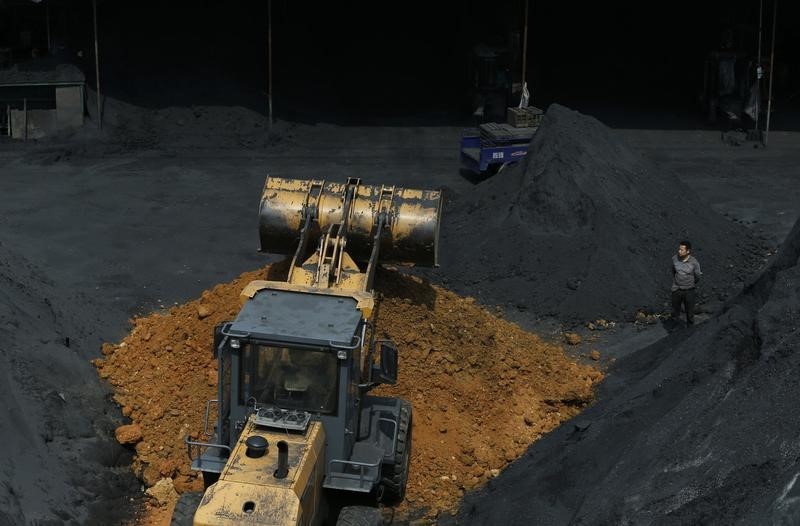(Repeats item issued earlier. The opinions expressed here are those of the author, a columnist for Reuters.)
By Clyde Russell
LAUNCESTON, Australia, Nov 1 (Reuters) - China's imports of coal from the seaborne market surged again in October, thereby justifying the jump in prices but also raising questions as to how much more of the fuel the world's top buyer can suck in.
Seaborne coal imports were 20.03 million tonnes for October, according to vessel-tracking and port data compiled by Thomson Reuters Supply Chain and Commodity Forecasts.
This is the highest monthly total since Thomson Reuters stated assessing the data in January 2015, and shows that China's appetite for imports remains undiminished in spite of a spike in the prices of both thermal and coking coal.
The seaborne data doesn't exactly match Chinese customs data as it excludes shipments from North Korea and overland from Mongolia, as well as coal that arrives on small vessels or barges. It may also be revised slightly in coming days as more data becomes available on when ships discharged cargoes.
However, seaborne imports are what matters from a market pricing perspective, as cargoes from North Korea and Mongolia tend not to affect the regional price benchmarks.
The seaborne imports for October are almost 3 million tonnes above the 17.06 million assessed for September, which represents a significant jump and will no doubt have contributed to a tightening of the market.
The benchmark Australian thermal coal price, the Newcastle weekly index GCLNWCWIDX , rose to $105.81 a tonne in the week ended Oct. 28, the most in 4-1/2 years and 109 percent higher than at the end of last year.
Australian premium hard coking coal .PHCC-AUS=SI , the regional benchmark for coal used in steel-making, rose to $257.70 a tonne on Monday, more than three times the $78.20 it fetched at the end of last year.
Despite these stellar gains, it's becoming harder to see how they can be sustained, especially since history shows that any spectacular rally is normally followed by a collapse.
While China's decision to cut its domestic coal output has no doubt been the driver of coal's gains this year, the question is how quickly can the Chinese reverse course, and how rapidly can coal exporters ramp up output to meet Chinese demand?
China's total coal output dropped 10.5 percent to 2.46 billion tonnes in the first nine months of the year compared to the same period in 2015, while imports have gained 15.2 percent to 180.18 million tonnes.
In volume terms, China's production is down by about 300 million tonnes in the first nine months of 2016, while imports are up by about 23 million tonnes.
This shows that higher imports have only compensated for about 7.6 percent of the drop in domestic output.
CHINA MINE OUTPUT IS KEY
What this means is that what China does with domestic output will have a far bigger bearing on the future of coal prices than anything coal exporters such as Australia, Indonesia and South Africa can do.
China has asked miners to quickly ramp up output ahead of the northern winter, and to cap prices at or below current spot market levels. thermal coal with a heating value of 5,500 kilocalories per kilogram, this implies a price of around 660 yuan a tonne, equivalent to about $97.48 a tonne, which is slightly below the current free-on-board price of Newcastle coal, which is of similar quality.
This implies that as soon as China can ramp up domestic coal output, the price of seaborne coal will likely fall to a level where it can compete, once freight and taxes are added.
Can China quickly ramp up coal output? Yes and no.
The positive is that the reduction in working days can likely be quickly reversed, meaning output from existing mines can ramp up.
The negative is that restarting idled mines takes far longer and owners have to be convinced that the higher prices are sustainable before committing fresh capital.
This applies to miners in exporting countries as well, where many have been burned by five years of losses from 2011 to 2015, a bleak period that saw capital and operating costs slashed and many mines hunker down in survival mode.
Right now many coal miners are happy to take the higher prices and rebuild cash reserves, while waiting to see if the rally can prove sustainable.
This suggests that prices will remain strong, at least until the market sees how Chinese domestic production responds to official entreaties for it to rise.
<^^^^^^^^^^^^^^^^^^^^^^^^^^^^^^^^^^^^^^^^^^^^^^^^^^^^^^^^^^^ Graphic of China coal imports vs. Newcastle price
http://tmsnrt.rs/2eOsyeQ
^^^^^^^^^^^^^^^^^^^^^^^^^^^^^^^^^^^^^^^^^^^^^^^^^^^^^^^^^^^> (Editing by Richard Pullin)
